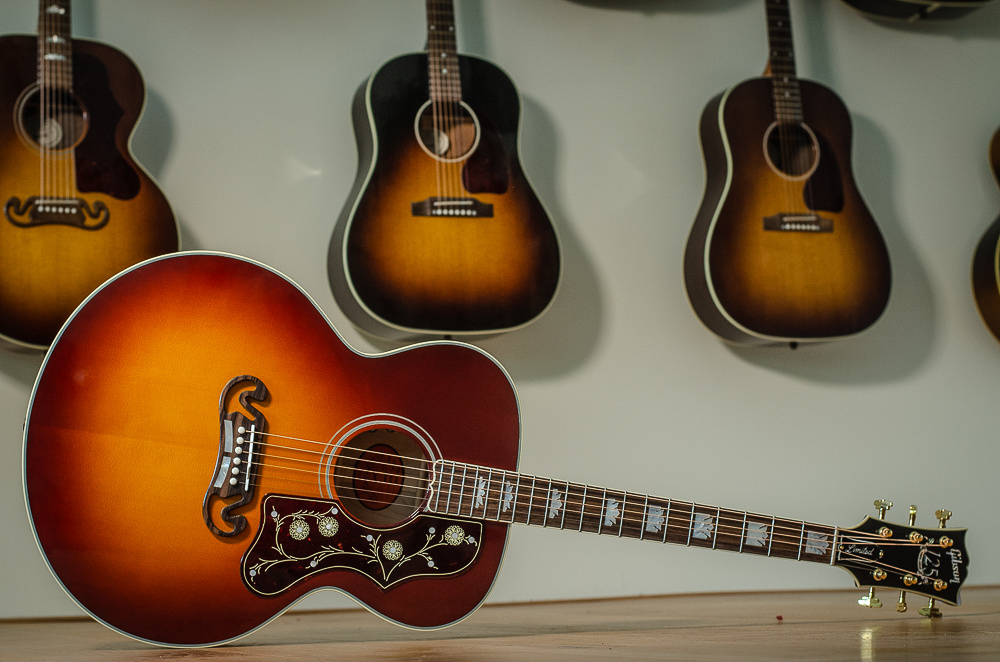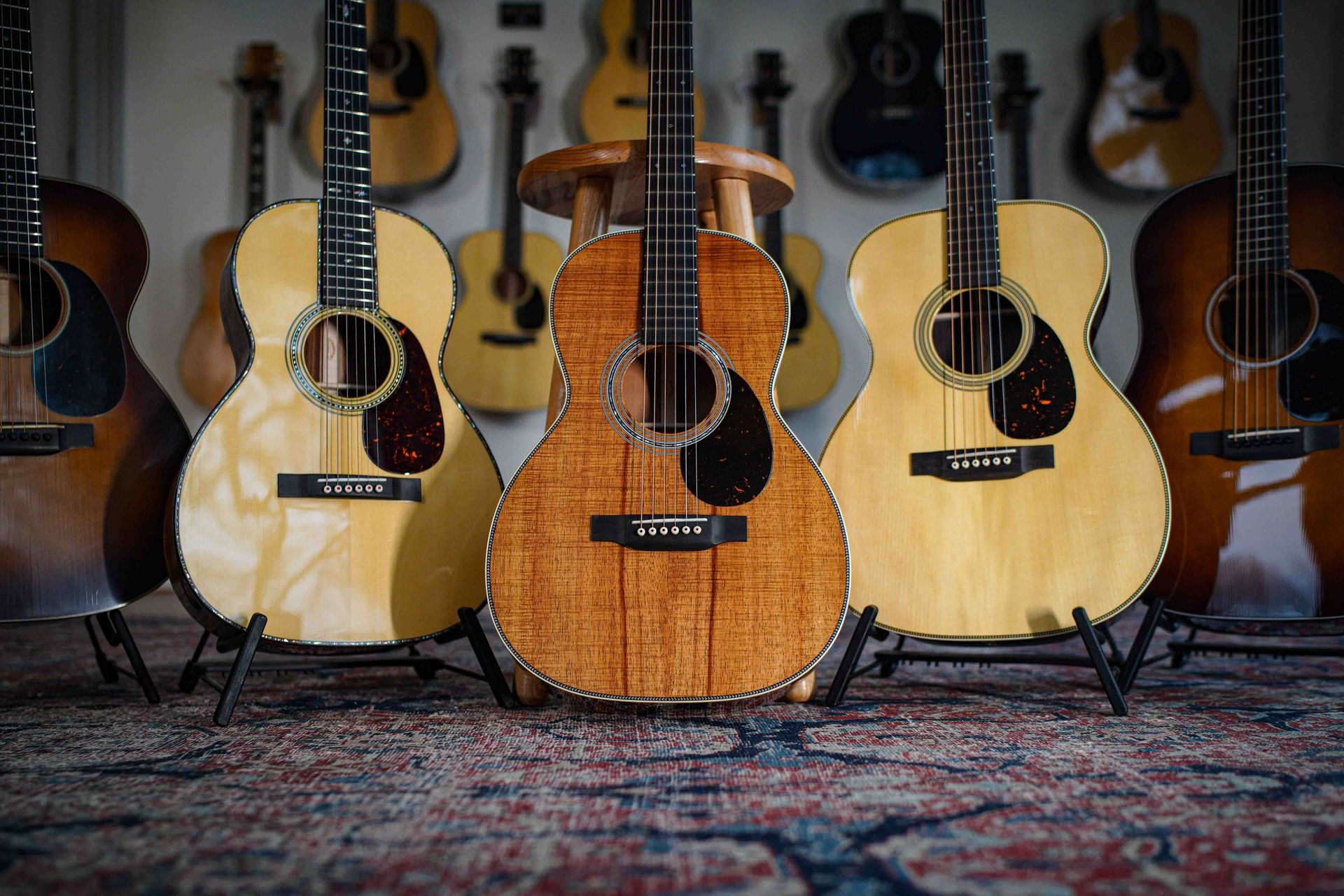Dreadnought
"By far the most popular model, and we totally get why (by the way, you can see it above!). A good Dreadnought can do it all! Over a century ago, it was conceived by the builders at Martin when they were looking for a guitar whose sound wouldn’t get lost in an orchestra. So, they made the body a bit larger and the neck slightly longer than was usual at the time. The result reminded the makers of a battleship, and that’s what this model was named after. Until 1916, 'dreadnought' was only known in the Navy. Back then, it was something unique, but today it’s the standard for many makers. How does it sound? In one word: grand! Are you looking for an all-rounder that already sounds great and will grow with you over the years? Then take a look at a Martin D18: pretty much the 'Mother of all dreadnoughts.
Great to strum chords, but separate notes in bluegrass and fingerstyle will ring like a bell. The size can be somewhat demanding, depending on your posture. And if you like playing on the couch at home, a dreadnought may get in the way. For this, the smaller OM Parlor or guitars are better suited.


Parlor
Also known as: O/OO and Parlour (United Kingdom)
f you were to compare guitars to dogs, parlor-guitars are just like Jack Russells: small, fierce, cheeky little rascals with lots of character, and they guarantee you a lot of fun! Thanks to their compact size, a parlor guitar is the perfect playmate for relaxing at home on the couch. Does that mean it's just a practice guitar? Definitely not! In the studio and on stage, the smaller body and usually shorter neck create a distinctive sound. Loud, with lots of projection, and with more emphasis on mid-range tones than bass. Pick up a parlor, like this one from Eastman, and you’re immediately transported to the 1930s, blues, folk, and traditional music.
OM
Also known as: OOO, (Grand)Concert
Due to the overwhelming success of the dreadnought, the Orchestra Model (OM) faded into the background for many years. But thanks to artists like Eric Clapton and John Mayer, the model has been dusted off and is making a strong comeback. Understandably so, because an OM offers the perfect middle ground between a dreadnought and a parlor guitar. Great for playing chords, fantastic for fingerpicking, a dream for blues, and all of this in a more manageable size. Compared to a workhorse like a dreadnought, an OM offers just a bit more finesse. With many variations available, such as slightly longer or shorter necks, more or less space between the strings, and a wide variety of special wood combinations, there's an OM out there to suit almost every player’s taste.


Jumbo
After the invention of the dreadnought, the search for more volume from a guitar continued. Without amplifiers, the builders at Gibson had little choice but to make the body even larger. And thus, in 1946, the Jumbo! Shortly after, it was followed by the SUPER Jumbo.
Jumbos are real showstoppers: if you see one, you have to look at it. And then look some more. As far as sound is concerned, the Jumbo offers something unique. Due to its enormous body and the sheer amount of wood that goes with it, the guitar sound is not just loud, but nicely wide instead. As a result, the sound of a Jumbo often fits wonderfully in the mix. So even though the size and looks of a Jumbo naturally take up center stage, in a modest role as an accompanying instrument the Jumbo really shines.
Grand Auditorium
Also known as: Fmodel, A-model
According to Taylor the Grand Auditorium was developed as the ultimate all-rounder. It's slightly smaller than a dreadnought but a bit larger than an OM. And that’s exactly how they sound: like the best of both worlds. This model has since become a standard and has been adopted and further developed by many other makers, such as the Australian Maton and the Czech company Furch.
The Irish brand Lowden has put its own unique spin on this model, particularly in their F-series, which we are very fond of.
Many people describe the sound as 'modern'. So great for pop songs, jazz, fingerstyle instrumentalists and singer-songwriters. Slightly less suitable for and blues. In addition to a parlor or an OM, you could also look at a slope shoulder for something more traditional.


Slope Shoulder
Which guitar suits me? Maybe the answer is "blowin' in the wind." Bob Dylan played that song on a slope shoulder guitar.This model was designed and produced by Gibson in 1942, with the J45 as the base model. The name of the song even hints at the original price back then: $45.
The model has stood the test of time very well and is gaining popularity among singer songwriters. Probably thanks to those gorgeous round shoulders and often stunning sunburst. Together they make a slope shoulder stand apart from a 'regular' dreadnought. Worth pointing out that Gibson also makes 12-fret slope shoulders to add a touch of extra playability.
Have you been looking for a dreadnought and still haven’t found what you are looking for? Try a slope shoulder. It might just be the one for you.
Looking further?
In the left column of our website you can search through hunderds of guitars not only by brand, but also by model.
We hope this information will help you on your way to your guitar. Do you want to know how a model sounds and plays? Feel free to visit The Fellowship of Acoustics.
De koffie en meer dan 800 gitaren staan klaar!
Looking for your ideal acoustic guitar?
We help you step by step in our Acoustic Guitar Buying Guide.
